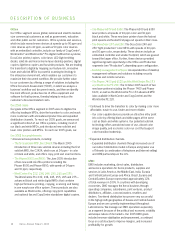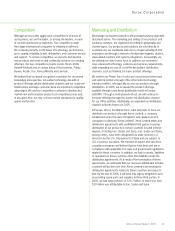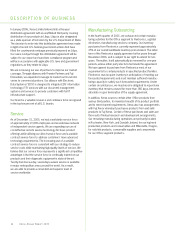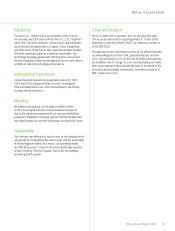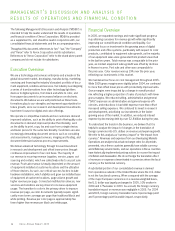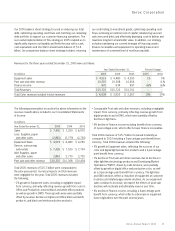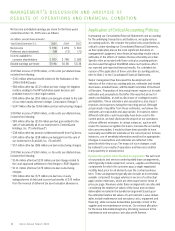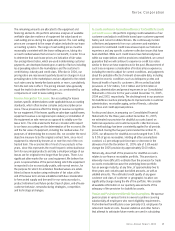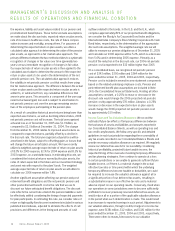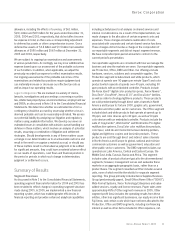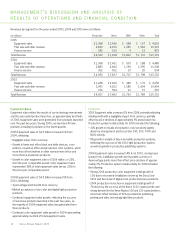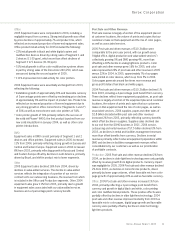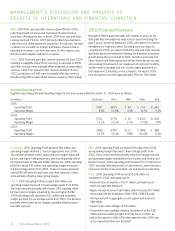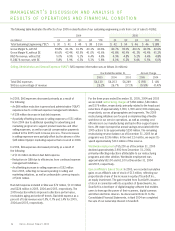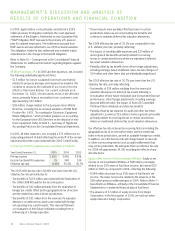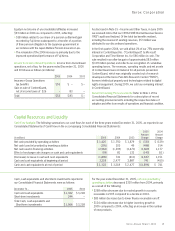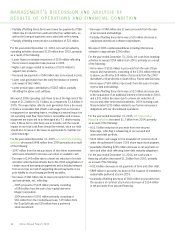Xerox 2005 Annual Report Download - page 38
Download and view the complete annual report
Please find page 38 of the 2005 Xerox annual report below. You can navigate through the pages in the report by either clicking on the pages listed below, or by using the keyword search tool below to find specific information within the annual report.
MANAGEMENT’S DISCUSSION AND ANALYSIS OF
RESULTS OF OPERATIONS AND FINANCIAL CONDITION
30
the expense, liability and asset values related to our pension and
post-retirement benefit plans. These factors include assumptions
we make about the discount rate, expected return on plan assets,
rate of increase in healthcare costs, the rate of future compen-
sation increases and mortality, among others. For purposes of
determining the expected return on plan assets, we utilize a
calculated value approach in determining the value of the pension
plan assets, as opposed to a fair market value approach. The
primary difference between the two methods relates to a systematic
recognition of changes in fair value over time (generally two
years) versus immediate recognition of changes in fair value.
Our expected rate of return on plan assets is then applied to the
calculated asset value to determine the amount of the expected
return on plan assets to be used in the determination of the net
periodic pension cost. The calculated value approach reduces
the volatility in net periodic pension cost that results from using
the fair market value approach. The difference between the actual
return on plan assets and the expected return on plan assets is
added to, or subtracted from, any cumulative differences that
arose in prior years. This amount is a component of the unrecog-
nized net actuarial (gain) loss and is subject to amortization to
net periodic pension cost over the average remaining service
lives of the employees participating in the pension plan.
As a result of cumulative historical asset returns being lower than
expected asset returns, as well as declining interest rates, 2006
net periodic pension cost will increase. The total unrecognized
actuarial loss as of December 31, 2005 was $1.9 billion, as
compared to $2.0 billion at December 31, 2004. The change
from December 31, 2004 relates to improved asset returns as
compared to expected returns, partially offset by a decline in
the discount rate. The total unrecognized actuarial loss will be
amortized in the future, subject to offsetting gains or losses that
will change the future amortization amount. We have recently
utilized a weighted average expected rate of return on plan assets
of 8.0% for 2005 expense, 8.1% for 2004 expense and 8.3% for
2003 expense, on a worldwide basis. In estimating this rate, we
considered the historical returns earned by the plan assets, the
rates of return expected in the future and our investment strategy
and asset mix with respect to the plans’ funds. The weighted
average expected rate of return on plan assets we will utilize to
calculate our 2006 expense will be 7.8%.
Another significant assumption affecting our pension and post-
retirement benefit obligations and the net periodic pension and
other post-retirement benefit cost is the rate that we use to
discount our futureanticipated benefit obligations. The discount
rate reflects the current rate at which the pension liabilities could
be effectively settled considering the timing of expected payments
for plan participants. In estimating this rate, we consider rates of
return on high-quality fixed-income investments included in various
published bond indexes, adjusted to eliminate the effects of call
provisions and differences in the timing and amounts of cash
outflows related to the bonds. In the U.S. and the U.K., which
comprise approximately 81% of our projected benefit obligations,
we consider the Moody’s Aa Corporate Bond Index and the
International Index Company’s iBoxx Sterling Corporates AA Cash
Bond Index, respectively, in the determination of the appropriate
discount rate assumptions. The weighted average rate we will
utilize to measure our pension obligation as of December 31, 2005
and calculate our 2006 expense will be 5.2%, which is a decrease
from 5.6% used in determining 2005 expense. Primarily as a
result of the reduction in the discount rate, our 2006 net periodic
pension cost is expected to be $32 million higher than 2005.
On a consolidated basis, we recognized net periodic pension
cost of $343 million, $350 million and $364 million for the
years ended December 31, 2005, 2004 and 2003, respectively.
Pension cost is included in several income statement components
based on the related underlying employee costs. Pension and
post-retirement benefit plan assumptions are included in Note
14 to the Consolidated Financial Statements. Holding all other
assumptions constant, a 0.25% increase or decrease in the
discount rate would change the 2006 projected net periodic
pension cost by approximately $35 million. Likewise, a 0.25%
increase or decrease in the expected return on plan assets
would change the 2006 projected net periodic pension cost
by approximately $15 million.
Income Taxes and Tax Valuation Allowances: We record the
estimated futuretax effects of temporary differences between
the tax bases of assets and liabilities and amounts reported in
our Consolidated Balance Sheets, as well as operating loss and
tax credit carryforwards. Wefollow very specific and detailed
guidelines in each tax jurisdiction regarding the recoverability of
any tax assets recorded in our Consolidated Balance Sheets and
provide necessary valuation allowances as required. We regularly
review our deferred tax assets for recoverability considering
historical profitability, projected future taxable income, the
expected timing of the reversals of existing temporary differences
and tax planning strategies. If we continue to operate at a loss
in certain jurisdictions or are unable to generate sufficient future
taxable income, or if there is a material change in the actual
effective tax rates or time period within which the underlying
temporary differences become taxable or deductible, we could
be required to increase the valuation allowance against all or
asignificant portion of our deferred tax assets, resulting in
asubstantial increase in our effective tax rate and a material
adverse impact on our operating results. Conversely, if and when
our operations in some jurisdictions were to become sufficiently
profitable to recover previously reserved deferred tax assets, we
would reduce all or a portion of the applicable valuation allowance
in the period when such determination is made. This would result
in an increase to reported earnings in such period. Adjustments to
our valuation allowance, through (credits) charges to income tax
expense, were $(38) million, $12 million, and $(16) million for the
years ended December 31, 2005, 2004 and 2003, respectively.
There were other increases/(decreases) to our valuation
Xerox Annual Report 2005


